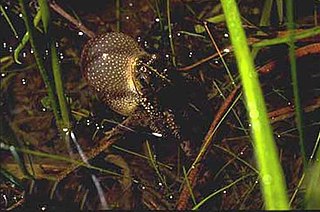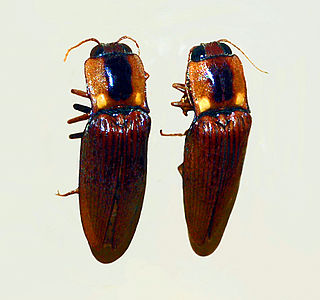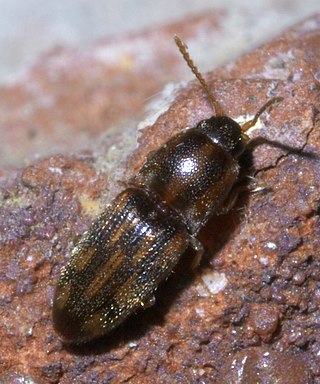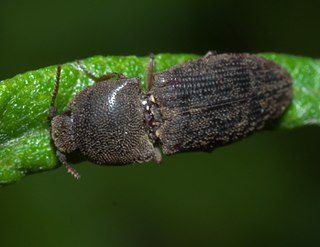
Pyrophorus is a genus of click beetle. They are one of several genera in the tribe Pyrophorini, all of which are bioluminescent. Their bioluminescence is similar to that of another group of beetles, the fireflies, although click beetles do not flash, but remain constantly glowing. They have two luminescent spots at the posterior corners of the pronotum, and another brighter light organ on the most-anterior surface of the ventral abdomen. This light organ is even brighter and can only be seen when in flight. Bioluminescent click beetles are found throughout tropical, subtropical and temperate America. Species from Texas, Florida, Puerto Rico, and Cuba are now in different genera in the tribe Pyrophorini, such as Deilelater and Ignelater.

Ignelater luminosus is a bioluminescent species of click beetle native to the island of Puerto Rico, one of several Caribbean species in the genus Ignelater that are known as cucubanos. Cucubanos are often confused with fireflies, which are in a different family (Lampyridae), but they emit light from the thorax, unlike true fireflies. Their paired prothorax light organs and single light organ on the anterior surface of the abdomen gives the appearance of two "headlights" and one "backlight", which it can turn off independently.

Rhinella dorbignyi is a South American species of toad in the family Bufonidae. The specific name, dorbignyi, is in honor of French naturalist Alcide d'Orbigny. Its common name is d'Orbigny's toad or Dorbigny's toad [sic].
Polynoncus is a genus of beetles of the Family Trogidae. It contains the following species:

Pyrophorus tuberculifer is a species of click beetle.

Pyrearinus candelarius is a species of click beetle.
Smodicum recticolle is a species of beetle in the family Cerambycidae. It was described by Brazilian entomologist Ubirajara R. Martins in 1975. The species S. recticolle was described as an orange beetle, with darkly colored antennae, and recumbent hairs, among other physiological characteristics. The insect was isolated in Argentina and is believed to be native to the Americas.

Monocrepidius is a genus of click beetles in the family Elateridae. The genus has often been cited as Conoderus, but of the two names for this genus published simultaneously in 1829, the one selected by the First Reviser under the ICZN was Monocrepidius, rendering Conoderus the junior synonym.

Agrypnini is a tribe of click beetles in the family Elateridae.

Agrypninae is a subfamily of click beetles in the family Elateridae. There are at least 130 genera and more than 430 described species in Agrypninae.

Ignelater is a genus of click beetle. They are one of several genera in the tribe Pyrophorini, all of which are bioluminescent. This genus was established by Cleide Costa in 1975. Most of the species were formerly in the genus Pyrophorus.

Deilelater is a genus of click beetles in the family Elateridae. They are one of several genera in the tribe Pyrophorini, all of which are bioluminescent. This genus was established by Cleide Costa in 1975, with 7 species split from Pyrophorus.

Vesperelater is a genus of click beetle. They are one of several genera in the tribe Pyrophorini, all of which are bioluminescent. This genus was established by Cleide Costa in 1975, with 4 species split from Pyrophorus.

The Pyrophorini are a New World taxonomic tribe within the Elateridae subfamily Agrypninae. Pyrophorini is a tribe of bioluminescent beetles, and includes such genera as Pyrophorus and Ignelater.
Campyloxenus is a bioluminescent genus of click beetles in the family Elateridae, and had been the sole member of the subfamily Campyloxeninae, until another monotypic genus Malalcahuello was described from Chile in 2015 as its new member. There is one described species in Campyloxenus, Campyloxenus pyrothorax, from southwestern Chile and Argentina.

Campyloxeninae is a subfamily of click beetles in the family Elateridae. It was established by Cleide Costa in 1975 with the genus Campyloxenus, former member of the tribe Pyrophorini under the subfamily Agrypninae, as the only member. In 2015, genus Malalcahuello was described from Chile as a new member of this subfamily.

Ampedus is a genus of click beetles in the family Elateridae. There are currently 461 recognized species of Ampedus beetles. It has a cosmopolitan distribution, but is found mostly in the Holarctic region, primarily in North America, Europe, and Asia. The oldest known fossil from this genus was found in Eocene Baltic amber, estimated to be from 38.0 to 33.9 million years ago.

Dipropus is a genus of click beetles in the family Elateridae. There are around 150 described species in Dipropus, found in North, Central, and South America.
Hypsiophthalmus is a genus of click beetles in the family Elateridae. They are one of several genera in the tribe Pyrophorini. This genus was established by French zoologist Pierre André Latreille in 1834 posthumously and then reviewed by Cleide Costa in 1975 and in 1979.
Opselater is a genus of click beetle. They are one of several genera in the tribe Pyrophorini, all of which are bioluminescent. This genus was established by Cleide Costa in 1975. After a revision of the genus by Simone Policena Rosa, she stated some members of this genus are polyphyletic with Lygelater bifossulatus(Candèze, 1865), which discouraged her from establishing any new genus in this part of Pyrophorini due to alternative resolutions and ambiguity.













